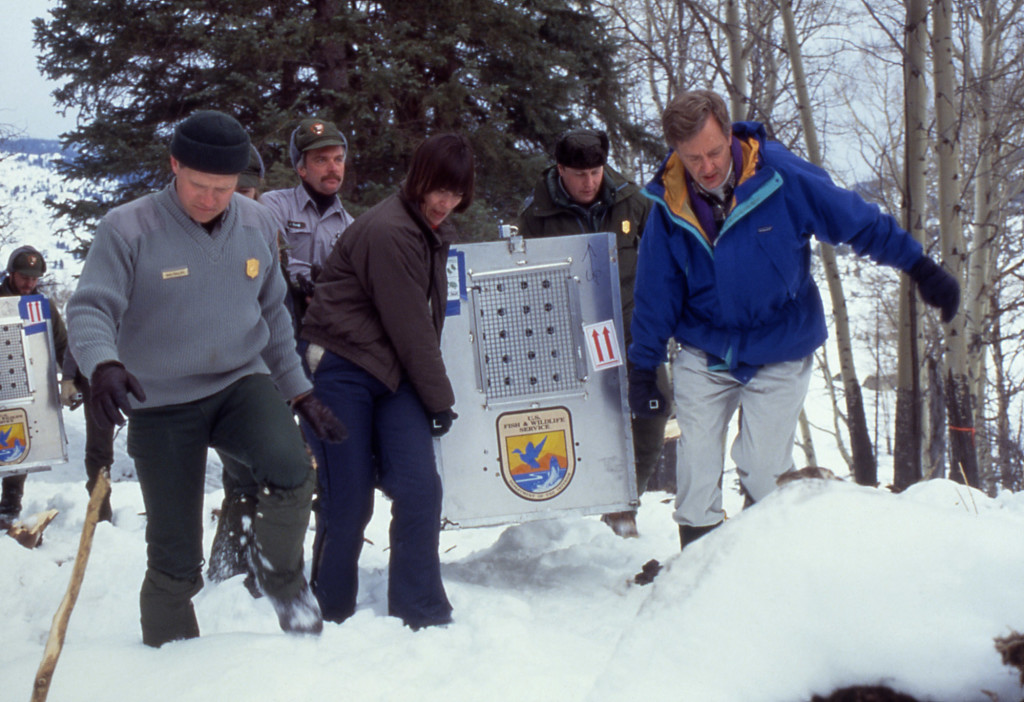2/9/15 – Wolf Reintroduction
February 9, 2015While not a find in the archives, we’ve just reached the 20th anniversary of a landmark event in environmental history: the reintroduction of wolves to Idaho and Yellowstone. In what a recent Idaho Statesman article called “one of the most controversial wildlife projects of the century,” in 1995 and 1996, 66 wolves were live-trapped in Canada and released in Yellowstone National Park and Idaho’s Frank Church River of No Return Wilderness.[i]

Mollie Beattie, Director of USFWS; Mike Finley, Yellowstone National Park Superintendent; and Bruce Babbitt, Secretary of the Interior carry the first wolf to be released in Yellowstone, Jan. 12, 1995. Source.
The issue remains controversial today. Biologically, the wolf population has largely recovered from the devastating effects of overhunting and habitat loss that first led to its Endangered Species Act listing. Today there are more than 1,600 wolves in at least 320 packs across the Northern Rockies, exceeding government goals. But such biological success has only increased human-wolf conflicts across that same geography, both when it comes to ranchers, who accuse wolves of killing far more livestock than research shows they actually kill, and in terms of preservationists, who prevented the wolves from being delisted from the Endangered Species Act for many years after populations had stabilized and still protest hunting of any sort. While the controversies tend to center around the animals themselves, ecologically the most exciting results of wolf reintroduction have to do with the cascading effects of top predators. For example, scientists in Yellowstone have shown that the reintroduction of wolves has decreased elk and beaver populations, thereby increasing willow, aspen, and cottonwood growth, changes that have had positive effects on river temperatures, runoff, and even groundwater recharge.[ii]
All of these data point to the success of the Endangered Species Act, which itself has had a controversial history. Not surprisingly, one of the biggest supporters of wolf reintroduction was also someone who fought to save the Endangered Species Act from opponents. She improved it and then spent her too-short career arguing that its largest effects were on whole ecosystems, not individual species, and that it could accompany, rather than crush, economic development. Mollie Beattie, Director of U.S. Fish and Wildlife from 1993 to her death in 1996, even released the first few wolves to Yellowstone herself, along with Secretary of the Interior Bruce Babbitt. She was a good friend of my family, and I’ve often wondered what the wolf controversy – and other controversies surrounding wildlife conservation – would be like today if she were still around to advocate and educate. Her legacy is vast – she was the first woman to direct Fish and Wildlife, and she has both a Yellowstone wolf pack and a wilderness area in the Arctic National Wildlife Refuge named in her honor – and it is tied inextricably to the reintroduced wolves. Their legacy, I suppose, is being written every day in innumerable aspects of the ecosystem and landscape of the Northern Rockies.

Mollie Beattie (1947-1996), Director of U.S. Fish and Wildlife Service, 1993-1996. Source.
– Naomi Heindel
From time to time, SHRA comes across fun, interesting and notable items in the archives that we think would be of interest to our readers but that don’t warrant a longer blog post. This piece is one of a series of vignettes that we hope will bring some of these discoveries to life. If you’re looking for one of our longer pieces, click on “Features” under “Categories” in the left navigation column.
____________________________________________________________________________
[i] Brett French, “20th Anniversary of Yellowstone Wolf Reintroduction Observed,” Idaho Statesman, Jan. 15, 2015. First published in The Billings Gazette. Rocky Barker, “Twenty Years Ago Today, 4 Wolves Were Released Into Idaho. What If It Never Happened?” Idaho Statesman, Jan. 14, 2015.
[ii] “Wolf Reintroduction Changes Ecosystem,” Yellowstone.
